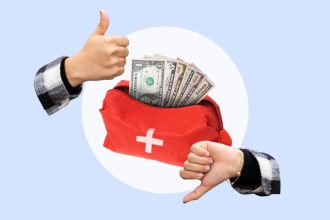Our writers and editors used an in-house natural language generation platform to assist with portions of this article, allowing them to focus on adding information that is uniquely helpful. The article was reviewed, fact-checked and edited by our editorial staff prior to publication.
Key takeaways
- You can find loans for borrowers with bad credit through community banks, credit unions and online lenders.
- Predatory or misleading loans can be disguised as bad credit loans.
- If the rate is above 35.99 percent, you’ll want to find a lower-interest option.
- Bad credit loans can come with challenges like higher interest rates and fees.
It’s not uncommon for those with less-than-stellar credit to have difficulty getting approved for a loan. This is in part because many lenders see low credit as a potential risk factor. Fortunately, there are loans for bad credit. Online lenders, community banks and credit unions all offer bad credit loans and work with borrowers across the credit spectrum.
Best place to get a loan with bad credit
The best bad credit loans are offered by online lenders, community banks and local credit unions. When starting your research process, look into the following institutions to avoid scams and predatory loans — like payday loans — or misleading lending practices.
Online lenders
Best for: Those who prefer to get a loan without visiting a brick-and-mortar location.
Several online lenders offer personal loans for applicants with lower credit. The application process is generally quick, and you should know your approval status within minutes of applying. If you are approved, funds may be disbursed as soon as the same day — although it usually takes one to three business days.
Given that there are a seemingly endless number of lenders, it can be easy to get overwhelmed. An online lending network can help reduce the noise.
These networks are online marketplaces that list reputable lenders offering the best bad credit loans. In some cases, they can often help you prequalify based on your needs. They also highlight the most important details, like the APR range and loan terms. Prequalifying allows you to see your eligibility odds and predicted APR without impacting your credit.
Banks or credit unions
Best for: Those who wish to bank locally, qualify for a credit union membership or want to take out a payday alternative loan.
Some local community banks will consider lending to people with bad credit — and they may offer competitive personal loan rates. Still, it can be difficult to get approved because most lending decisions are based solely on your creditworthiness and income. If you strike out at your local bank, you may have more luck with your local credit union — provided you meet all the membership requirements.
A personal loan from a credit union may be easier to qualify for than community banks but require membership. Most have fairly simple membership requirements based on occupation, association or area of residence.
Each credit union serves a different group and may operate on a local, state or national level. Some federal credit unions offer payday alternative loans (PALs) geared toward borrowers with bad credit. These PALs carry annual percentage rates (APRs) that cap out at 18 percent, compared to payday loans, which can have APRs as high as 400 percent.
Pay advance apps
Best for: People with steady paychecks who need a quick boost to their bank account.
Pay advance apps are designed to help you access your paycheck earlier than your expected deposit date. Due to the nature of this method, you’ll need to have a steady source of income. Regardless of your credit score, the more predictable your paycheck is, the more likely you will qualify for an advance.
A paycheck advance isn’t a loan, and there is no interest charged. However, these apps may charge subscription fees, express funding fees or request optional tips. The fees may seem small, but remember that a fee of $15 for a $500 cash advance is equivalent to an APR of nearly 36 percent.
On top of any potential fees, keep in mind that you’ll be drawing from your future income when you use a pay advance app. This means you’ll receive a smaller paycheck on your next payday.
Bad credit loans to avoid
Some bad credit loans can be predatory with unreasonably high interest rates and extremely tight payment timelines. These options should only be used as a last resort.
Payday lenders
Payday lenders offer small short-term loans, typically up to $500. It’s easy to get approved for these products even if you have bad credit, but there are significant drawbacks: You’ll pay a hefty APR, sometimes over 400 percent, and only have a short window to repay what you owe.
One challenge borrowers may face with a payday loan is paying back the loan by the due date, which is typically the next payday. Unfortunately, this often leads to even more fees and a perpetual high-interest debt cycle that can be very challenging to end. Despite their convenience, payday loans should only be used if you’re sure you can pay off the entire balance by the due date.
Title lenders
Title lenders also cater to borrowers with bad credit scores. Car title loans are installment loans that are relatively easy to qualify for because they use your car as collateral. You must own your car in full — meaning you don’t have an auto loan — to qualify.
In most cases, you’ll make equal monthly payments over a set period, usually up to six months. You could also get a slightly lower APR than with a payday loan.
Still, this type of loan is risky since it uses your vehicle to secure it. If you fall behind on your payments, your lender could repossess your car. And although the APR may be lower than a payday loan, it is still much higher than other loans for bad credit.
How to qualify for a loan with bad credit
Traditional personal loans may be hard to qualify for, but getting a personal loan with bad credit is possible. To put yourself in a good position, check lender requirements and consider waiting if you can.
- Check your credit score: Before you apply for anything, check your credit score. The lower your score, the more challenging it may be to qualify for a loan. If you can, try to improve your credit before applying. This will increase your chances of qualifying — and help you score a better rate.
- Review your income and debt: When applying for a bad credit loan, lenders will want to see that you have the cash flow to cover monthly payments. They will do this by assessing what is known as your debt-to-income ratio, or DTI.
- Apply with a co-signer or co-borrower: Asking a co-signer or co-borrower with excellent credit to apply with you can help you qualify, but it will negatively affect their credit if you mismanage the loan.
- Prequalify first: Loan applications require a hard credit check, temporarily knocking your score down about 10 points. Prequalification doesn’t guarantee approval but lets you see your predicted rates without impacting your credit. Most lenders offer it, so it’s smart to use this tool to avoid harming your credit until you’re ready to borrow.
- Shop around: To secure the best rate and terms possible, take the time to compare at least three different lenders as offers can vary significantly from one lender to the next.
- Know the risks: Lenders who provide loans to individuals with bad credit may charge higher fees and interest rates. It’s important to fully understand the costs associated with the loan and ensure you can make timely payments.
The bottom line
Bad credit loans can help you get out of a financial bind. They are often more costly than personal loans, so borrow with caution.
Familiarize yourself with each option and the benefits and drawbacks of bad credit loans, and get quotes from at least three lenders to find the most competitive loan offer. Depending on the loan terms, you could be better off cutting expenses to free up funds, applying for a credit card or finding other bad credit loan alternatives.
Frequently asked questions about bad credit loans
-
Common types of bad credit loans include traditional personal loans, loans with a co-signer, secured loans and payday advances.
-
Qualifying for a bad credit loan depends on the lender and the type of loan you are applying for. Generally, you will need to have a steady source of income and may need to provide collateral or a co-signer.
-
Yes, there are risks associated with bad credit loans. Borrowers are usually charged higher fees and face a higher average interest rate. Some loans may also require collateral. It’s important to be aware of the costs associated with the loan and have a plan to make timely payments before you apply.
Read the full article here














